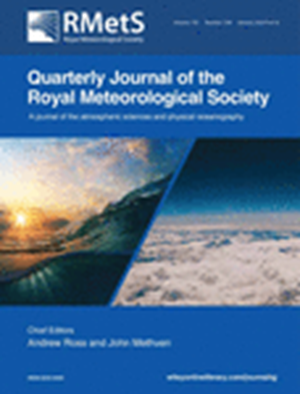Physics–dynamics–chemistry coupling across different meshes in LFRic‐Atmosphere: Formulation and idealised tests
IF 2.9
3区 地球科学
Q2 METEOROLOGY & ATMOSPHERIC SCIENCES
引用次数: 0
Abstract
The main components of an atmospheric model for numerical weather prediction are the “dynamical core,” which describes the resolved flow, and the “physical parametrisation,” which capture the effects of non‐fluid and non‐resolved fluid processes. Additionally, models used for air quality or climate applications may include a component that represents the evolution of chemicals and aerosols within the atmosphere. Though, traditionally, all these components use the same mesh with the same grid spacing, we present a formulation for the different components to use a series of nested meshes, with different horizontal grid spacings. This gives the model greater flexibility in the allocation of computational resources, so that resolution can be targeted to those parts that provide the greatest benefits in accuracy. The formulation presented here concerns the methods for mapping fields between meshes and is designed for the compatible finite‐element discretisation used by LFRic‐Atmosphere, the Met Office's next‐generation atmosphere model. Key properties of the formulation include the consistent and conservative transport of tracers on a mesh that is coarser than the dynamical core, and the handling of moisture to ensure mass conservation without generation of unphysical negative values. Having presented the formulation, it is then demonstrated through a series of idealised test cases that show the feasibility of this approach.LFRic-Atmosphere 中不同网格间的物理-动力-化学耦合:公式化和理想化测试
用于数值天气预报的大气模式的主要组成部分是 "动力学核心 "和 "物理参数"。"动力学核心 "描述已解析的气流,而 "物理参数 "则捕捉非流体和非解析流体过程的影响。此外,用于空气质量或气候应用的模型可能包括一个表示大气中化学物质和气溶胶演变的部分。虽然传统上所有这些组件都使用相同网格间距的网格,但我们提出了一种不同组件使用一系列嵌套网格、不同水平网格间距的方案。这样,模型在分配计算资源时就有了更大的灵活性,从而可以将分辨率集中在那些能提供最大精度优势的部分。本文介绍的公式涉及网格间场的映射方法,是为英国气象局下一代大气模型 LFRic-Atmosphere 所使用的兼容有限元离散化设计的。该公式的主要特性包括:在比动力学核心更粗糙的网格上对示踪剂进行一致的保守传输,以及处理水分以确保质量守恒而不会产生非物理负值。在介绍了该公式之后,我们将通过一系列理想化的测试案例对其进行演示,以证明这种方法的可行性。
本文章由计算机程序翻译,如有差异,请以英文原文为准。
求助全文
约1分钟内获得全文
求助全文
来源期刊
CiteScore
16.80
自引率
4.50%
发文量
163
审稿时长
3-8 weeks
期刊介绍:
The Quarterly Journal of the Royal Meteorological Society is a journal published by the Royal Meteorological Society. It aims to communicate and document new research in the atmospheric sciences and related fields. The journal is considered one of the leading publications in meteorology worldwide. It accepts articles, comprehensive review articles, and comments on published papers. It is published eight times a year, with additional special issues.
The Quarterly Journal has a wide readership of scientists in the atmospheric and related fields. It is indexed and abstracted in various databases, including Advanced Polymers Abstracts, Agricultural Engineering Abstracts, CAB Abstracts, CABDirect, COMPENDEX, CSA Civil Engineering Abstracts, Earthquake Engineering Abstracts, Engineered Materials Abstracts, Science Citation Index, SCOPUS, Web of Science, and more.

 求助内容:
求助内容: 应助结果提醒方式:
应助结果提醒方式:


